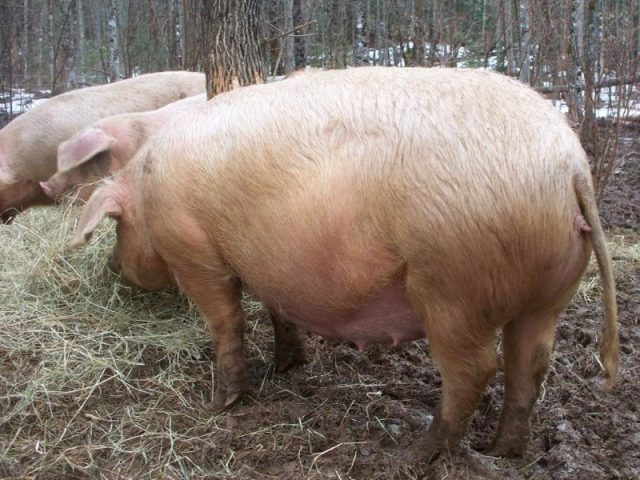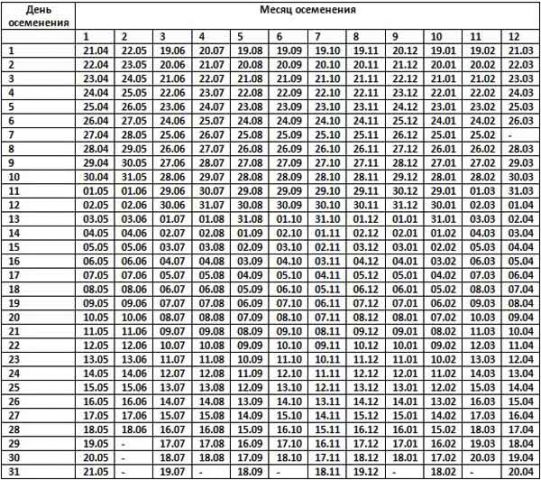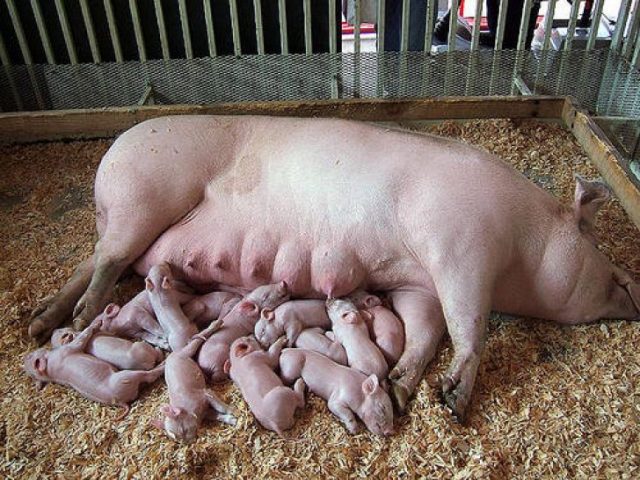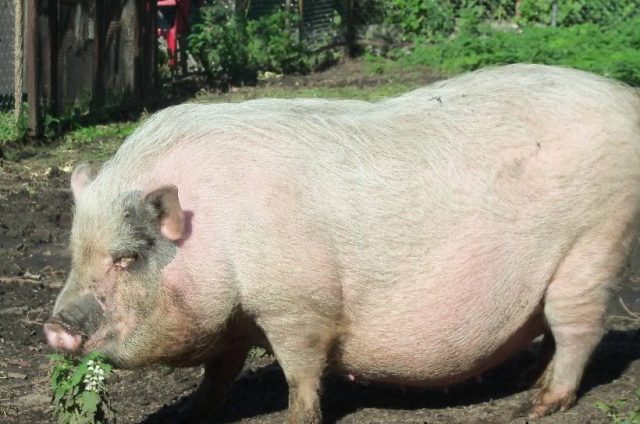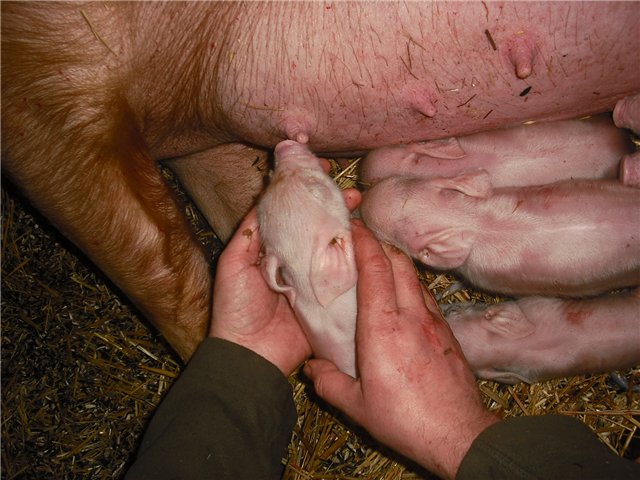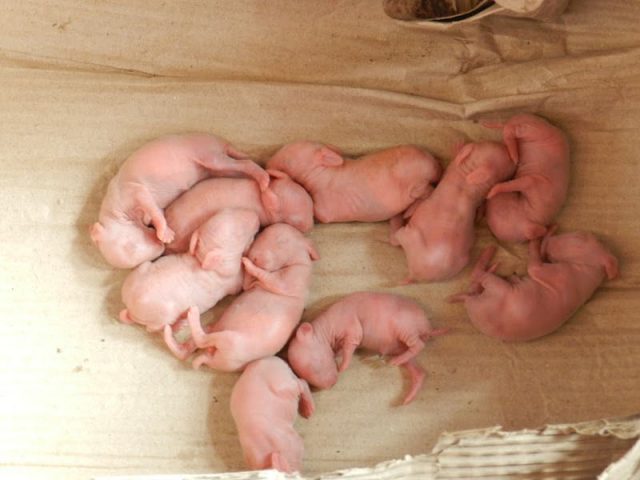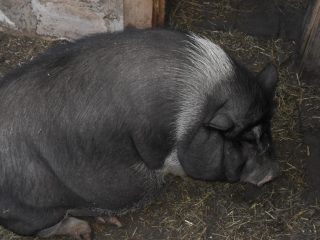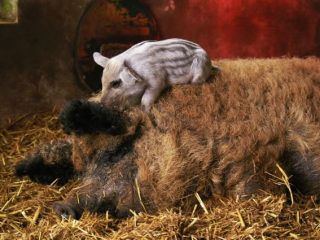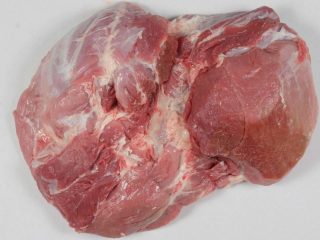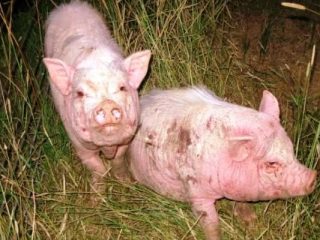Content
Any pig breeder will sooner or later want to breed offspring from his charges. And the vitality of the offspring and the further fate of the sow depend on how correctly the care of the pigs during pregnancy and how competently the farrowing process will take place. Farrowing pigs for the first time is especially important, as it lays the foundation for their entire future as sows.
Preparing a pig for the first pregnancy
When preparing a pig for its first pregnancy, it is very important to understand:
- which individuals are best suited for breeding;
- when puberty occurs in animals;
- how to determine that a pregnancy has occurred.
Not every pig is capable of producing healthy and high-quality offspring. First of all, only zoned breeds should be bred, they are more hardy and unpretentious. Particular attention should be paid to the constitution and structure of the body of the pig:
- the body must be strong and healthy;
- the animal must have a strong skeleton with a wide back part;
- the abdomen should not sag;
- in the udder of a pig there must be at least 12 well-formed nipples, which are at a decent distance from each other;
- the lower teats should not be covered by the upper ones so that all piglets have free access to them.
It is also very important that the pig intended for breeding has a calm and docile nature. At the same time, she showed healthy activity, excellent appetite and moved a lot.
It should be recognized that young pigs already at a fairly early age (5-6 months) experience a craving for mating. But a serious-minded pig breeder should not allow his charges to mate at this age. Otherwise, the offspring may be very weak or completely lifeless. Better to wait until young pigs are 9-10 months old. Usually at this age they reach 100 kg in weight and their body is already more prepared for bearing piglets. In some late-maturing breeds, the time of the first mating occurs after a year.
Since pigs come to hunt after the onset of puberty throughout the year, after certain cycles of 18-24 days, then the time for the first mating must be chosen the most convenient for the owner. It is best to do this in such a way that farrowing occurs not in the coldest, and also not in the hottest months of the year.
Signs of the onset of heat or heat are as follows:
- pigs refuse to eat for no reason;
- their behavior becomes restless, they begin to jump on other animals;
- the genitals swell and turn red, mucus begins to stand out from them;
- when a boar appears, the pigs first seem to fall into a stupor, and then behave quite actively.
The heat usually lasts from 2 to 4 days. But the boar must be allowed near the pig in the first two days, otherwise mating may not work.
When a pig carries a pregnancy, its behavior usually changes dramatically.
- animals express calmness and indifference to the world around them and even lose interest in food;
- despite some indifference to food, the mass of the pig begins to increase;
- from the genitals, there is a discharge of cheesy formations;
- the pig's nipples begin to turn red and swell, preparing for feeding;
- During the next hunt, all signs completely disappear.
True, there is such a phenomenon as a false pregnancy of pigs, in which all of the above symptoms also take place.
There are also several simple folk ways to determine whether pigs are pregnant or not.
Method 1 - the pig breeder calms the animal and, in a standing position, strokes it on the back from the shoulder blades to the back. In the normal state, the pig will definitely bend, but the pregnant female will stand evenly and calmly. This method gives a guarantee of pregnancy from 80 to 90%.
Method 2 is based on the fact that in the next hunting period (that is, after about 20 days), the boar is again launched to the pig. A pregnant animal will not pay any attention to him, while an ordinary female will behave quite actively with him.
However, if after 2-3 weeks the signs of early pregnancy in the pig did not disappear, then, most likely, the process began to develop actively.
How long does a pig pregnancy last?
It is estimated that the average gestation period in pigs lasts 3 months + 3 weeks + 3 days. Which together is exactly 114 days after mating. But this rule just makes it easy to remember the numbers. In fact, pig gestation can easily fall between 110 and 125 days. According to statistics, only 25% of sows piglet after exactly 114 days. 30% of animals give birth to offspring at an earlier date, and 45% at a later date.
It is only important that the gestation period is at least 110 days. If farrowing earlier than this period, the life of newborn piglets is at risk.
How many days a pig carries piglets depends on several factors:
- The age of the sows. The gestation period before the first or even the second farrowing may increase by 5-7 days. Conversely, mature pigs are able to farrow 7-10 days earlier than the average.
- Climatic conditions and seasons. In summer, the gestation period is slightly longer than in winter.
- The number of piglets hatched. Oddly enough, but a larger number of offspring obtained requires shorter periods of their bearing.
- Breed of animals. Usually, the smaller the animals, the shorter their gestation period. For example, Vietnamese pot-bellied pigs carry babies for 114 to 118 days, while in large white sows gestation lasts from 114 to 122 days.
- The conditions of keeping also have an impact, the better they are, the longer the pig can carry its cubs.
Sow farrowing table
For a more accurate determination of the timing of the farrowing of a sow, experienced farmers advise using a special calendar.
Usually it is created in the form of a table that allows you to determine the earliest date from which you need to be ready for farrowing at any time.
It is quite easy to use this pig farrowing calendar as a table.
In the first vertical column, you need to find the number when the pig was actually mated, and in the uppermost horizontal line is the month when this event occurred. In the cell where the found row and column intersect, the date is written from which it is necessary to expect farrowing every day.
How many times does a pig give birth per year
Most pets only breed once a year, or even less often. But the peculiarity of the sow is the fact that it is quite capable, given favorable conditions, to farrow twice a year. At the same time, bring perfectly healthy and viable offspring.
How many piglets a pig can bring at a time
It is not for nothing that a pig is considered a multiple animal - it is capable of bringing about a dozen or more piglets at a time.
It is rather difficult to determine their exact number in advance. The fact is that the number of piglets in a litter is influenced by several factors:
- pig breed;
- her age;
- number of previous farrowings;
- health status;
- food;
- hereditary productivity.
At the first farrowing of pigs, the number of cubs usually does not exceed 6-8 pieces. In subsequent years, the number of piglets in a good sow should gradually increase with each farrowing. A mature pig at the age of 2-3 years can already give birth to 10-12 piglets. The most fertile individuals bear 15 to 20 cubs.
A lot is determined by the breed of animals. While Chinese pigs are capable of producing about 20 piglets on average, representatives of the usual large white breed are only about 12-14 heads.
Preparing for farrowing
Only with the help of a properly organized process of feeding and caring for pigs during pregnancy, it is possible to avoid most of the problems with farrowing at home, especially for the first time. There is a difference in feeding during pregnancy between young (primiparous) and mature sows
Young pigs still continue to grow and develop intensively, so they need a lot of protein feed. For the entire period of gestation, a primiparous pig should gain 45-55 kg of live weight.
Older pigs no longer need such an amount of protein food, since they only need to maintain their own weight to carry piglets. Their mass is carefully monitored throughout pregnancy. They should not gain more than 40-45 kg.
The last month is especially important, during which the pig can gain two-thirds of its total weight. In the last weeks before giving birth, the pig is transferred to a diet of high-quality hay, liquid bran and flaxseed flour. To prevent constipation, it is necessary to regularly add beet pulp to food.
Feed must be served 3 times a day. And in the drinking bowls, fresh drinking water should be present around the clock.
Pregnant pigs are not allowed to include in the diet:
- hard cake;
- chaff;
- sunflower husk;
- frozen and rotten feed.
Signs of approaching farrowing
In order not to miss the exciting moment of childbirth, when pigs may need additional human help, every pig breeder should be aware of the main signs of the upcoming event.
The signs of farrowing of a sow giving birth for the first time practically do not differ from that of a mature pig, except that they are slightly less pronounced.
About 4-5 days before farrowing, the sow turns distinctly pink and begins to swell the vulva or loop, which is located at the prenatal opening. If this has not yet been done before, the pig from this moment must be placed separately, in a special farrowing pen. This is necessary so that during farrowing and in the future, a bulky and massive animal has less opportunity to accidentally crush its newborn babies.
Approximately 2 days before farrowing, a loose udder can be observed in a pig as colostrum production begins. Also, the belly sags quite a lot and the spine sags.
The day before the expected birth, the behavior of the pig changes: it behaves restlessly, often jumps up, lies down, grabs the bedding with its mouth, makes a nest for itself. Make sure she has enough sawdust, good quality straw, or corn husks in her pen. After some time, colostrum may already appear from the nipples when pressed, and mucus begins to be released from the genitals. From these signs, you can easily tell that the pig will soon farrow.
It should be understood that the first birth is usually the most difficult and may well pass with some delay. This is completely normal. Before the very beginning of labor, the pig usually calms down and lies on its side in some secluded corner. The beginning of contractions and wagging of the tail indicate the first contractions.
Preparation of the machine, tools and disinfectants
All walls of the room in which farrowing will take place are whitewashed with slaked lime. The machine itself is also treated with a disinfectant solution (for 0.5 liters of hot water, 100 g of alkali). The litter is completely changed to fresh.
For the piglets, it is necessary to prepare a separate warm corner with a fixed infrared lamp. The room should be free of drafts, but not too hot. The optimum temperature is about + 18-20 ° С. If farrowing occurs in summer, on hot days it is necessary to spray the woman in labor with cool water.
The pig itself, a few days before farrowing, is washed with soapy water, and then treated with an antimicrobial agent (1% creolin solution). Be sure to place a drinking bowl, preferably a metal one, in which the water is changed at least 2-3 times a day. One pig should consume at least 25-30 liters of water per day.
A bag with tools and materials for assisting in childbirth should be ready:
- scissors for cutting the umbilical cord;
- strong thread for tying it up;
- 5% iodine or brilliant green for processing the umbilical cord;
- clean, soft diapers with which the piglets are wiped;
- disposable sterile gloves;
- freshly prepared solution of potassium permanganate.
A container of warm water and soap should also be prepared.
Farrowing pigs at home
For sows who are piging for the first time, it is especially important to create a calm atmosphere during childbirth. Undesirable noises and the presence of strangers. It will be good if a person who cares for them is constantly with young pigs. On average, depending on the strength of the pushing, farrowing in pigs giving birth for the first time lasts about 6 hours. With a favorable outcome, everything can be completed in 2-4 hours, and if the attempts are weak, then farrowing can continue up to 9 hours.
With an interval between attempts of 4 minutes, amniotic fluid usually begins to flow. Most often, the first piglet is the largest and therefore comes out longer than the rest. Other piglets are usually born every 20-25 minutes.
Before the start of labor, the nipples of the pig are wiped with a weak solution of potassium permanganate.
Newborn piglets are wiped with a clean diaper, if necessary, the respiratory tract is cleaned.
Having measured about 5 cm from the calf's body, the umbilical cord is cut off, and the cut site is treated with brilliant green or iodine. In cold weather, piglets must be dried under an infrared lamp. The piglets are then applied to the mother's nipples.
Pig colostrum contains the most valuable substances for the immature immunity of babies, so it is vital for them in the first hour of their life. If this is not done, the piglets will most likely not survive.The nipples located closer to the sow's head are usually fuller. It is to them that the weakest piglets should be applied, so that it is easier for them to suck the portion of colostrum they need.
Before each birth of the next piglet, the pig's hind leg begins to twitch and wag its tail. If all these movements stop, then, most likely, the process of childbirth is over.
But after the birth of piglets, after 3-6 hours, the afterbirth usually comes out. It is very important to wait until it comes out and remove it immediately so that the pig does not have the opportunity to eat it. If, after 8 hours after the end of farrowing, the placent has not come out, it is necessary to urgently call a veterinarian.
After the end of childbirth, the back of the pig's body is washed with warm water and the old litter is completely replaced with a new one.
It is allowed to feed the sow after farrowing no earlier than 2 hours after the end of the process. But water with sugar can be given immediately to restore strength. It is better if after the release of the placenta the pig itself gets on its feet and drinks, and even eats a little.
Complicated farrowing
The first thing that can alert you during farrowing if contractions are weak or rarely occur. In this case, you can try to force the pig to stand up and move, give it a belly massage or drink it with sweet water.
In case of premature withdrawal of amniotic fluid into the birth canal of a pig, a decoction of flaxseed or pre-boiled and cooled sunflower oil can be injected.
With prolonged non-opening of the cervix, hot (+ 45 ° C) boiled water can be poured into the birth canal.
What to do if a pig cannot farrow
In the case of the first farrowing, the birth canal may be too narrow, and the process itself may be painful for the pig. In this case, you can use an antispasmodic for the uterus with the main active ingredient Vetrabutinhydrochlorid. This drug is injected into the pig's uterus, resulting in relaxation and pain relief. The use of oxytocin can stimulate labor, and calcium can support the contraction of the pig's uterus.
If the fetus is not positioned correctly or if it is too large, the farrowing process can also be delayed. And if there is no veterinarian nearby, then you will have to act yourself.
This requires the examiner's hand to be small and narrow. A glove lubricated with a special gel or petroleum jelly is put on the hand and inserted into the sow's vagina. If the position is wrong, they try to turn the piglet. In the case of a large calf, they try to take it by the legs and pull it out at the time of the next fight.
So that contractions during farrowing do not weaken, already born piglets are applied to the nipples. Because sucking stimulates labor.
If after birth the pig does not breathe, then you can try to give him a heart massage, do artificial respiration.
Care rules after farrowing
After successful farrowing, it is important that the pig is able to fully feed and raise all the piglets that are born.
How to feed a sow for more milk
12 hours after farrowing, the pig can be fed a liquid oat bran mixture for milk production. It is not recommended to give corn and rye, as they lead to a decrease in the amount of milk.
For the first 2 weeks, the feed for the sow should be predominantly liquid. It is diluted with water in a ratio of 1: 3.
One pig should receive per day:
- 1.5 kg of hay or fresh grass;
- 10 kg of juicy feed;
- 4 kg of concentrated feed.
How to care for a sow and piglets
Within 5 days after farrowing, the pig may experience spotting from the birth canal. Gradually they become lighter and more transparent, and then they stop. If this does not happen, you should contact your veterinarian.
While feeding the babies, the pig can keep them away from the udder, lie down on the stomach.In this case, you need to inspect the udder and if small wounds are found on it, then the milk canines of the pigs are blunt by 2 mm using forceps.
Possible problems
Some of the potential problems have already been discussed in the chapter describing the farrowing process.
What to do if the pig walks
If a pig is piging for the first time, delaying labor is considered almost normal. The main thing is to provide the sow with at least some activity and an influx of fresh air.
Why does a pig eat its piglets
If a pig is allowed to swallow its placenta during farrowing, it will be able to eat its piglets in the future. Therefore, this cannot be allowed.
What to do if the sow does not eat or get up after farrowing
Often, especially in the case of prolonged or complicated births, excessive fatigue accumulates in the pig's body. In this case, she needs to offer sweet water and help to get up. If all attempts are unsuccessful, then the problems may lie deeper. Perhaps the presence of inflammatory processes or problems with the gastrointestinal tract. In these cases, the pig needs urgent veterinary assistance.
How many farrowings do the sows change?
The term of use of a sow in a subsidiary farm depends on its characteristics of multiplicity, milk production, as well as the safety of piglets during the suckling period. If all these characteristics are high, then the pig is kept for at least 4-5 years to receive at least 6-7 farrows from them. Indeed, the maintenance of a mature pig requires less feed than a young uterus. In addition, sows usually show their maximum productivity at the age of 2 to 5 years.
Conclusion
Farrowing pigs for the first time is too demanding business, which in the absence of the necessary knowledge and skills may end and not very satisfactorily. Therefore, it is necessary to assess your strengths and, if necessary, be sure to call a specialist for help.

